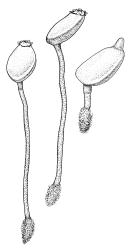Plants solitary or gregarious, on soil. Stems minute, rarely observed unless fertile, arising from ± persistent and pale protonemata. Leaves minute, persistent at base of the setae, brown, lingulate, lanceolate, or irregular, toothed or ciliate. Mid laminal cells ± oblong. Costa absent.
Reportedly dioicous. Female plants minute, reportedly with a single archegonium. Male plants minute, reportedly of a single bract-like leaf enclosing one antheridium, not seen in N.Z. material. Setae stout, smooth or papillose, swollen at base and surrounded by few or numerous persistent leaves; capsules very large, remaining green until nearly fully mature, asymmetric at base, inclined or erect, obovoid, uniformly convex or flattened on upper surface, with a small and inconspicuous neck; stomata in a single row at the base of the neck, superficial or immersed; exothecial cells often exfoliating; operculum high-conic. Peristome double; exostome nematodontous, of 1–4 rows of irregular (sometimes rudimentary) teeth, smooth or papillose; endostome a pale, pleated cone, usually exceeding the exostome in height. Calyptra cucullate, naked, covering only the operculum.
| 1 | Setae distinctly papillose; capsules strongly inclined or horizontal, 3–5 mm, broadly obovate with the upper surface nearly plane and surrounded by a distinctly raised border; mouth surrounded by flaps of exfoliating exothecial cells | B. aphylla |
| 1' | Setae smooth; capsules erect, 6–9 mm, narrowly obovate and uniformly convex; mouth not surrounded by exfoliating exothecial cells | B. novae-zelandiae |
| Category | Number |
|---|---|
| Indigenous (Endemic) | 1 |
| Indigenous (Non-endemic) | 1 |
| Total | 2 |
A genus of c. 10 species distributed mostly in temperate regions. Two species occur in N.Z.
Sterile material is rarely, if ever, collected. The relatively large capsules, borne on stout setae, persist for more than one year. The vegetative leaves of all species are minute and probably contribute little to the nutrition of the developing sporophyte. The Australian species of Buxbaumia were discussed by Stone (1983) and her notes included observations on N.Z. species.




